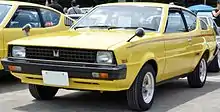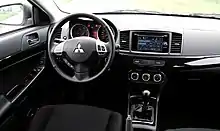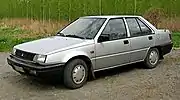Mitsubishi Lancer
The Mitsubishi Lancer is a compact car produced by the Japanese manufacturer Mitsubishi since 1973.
| Mitsubishi Lancer | |
|---|---|
_VR_sedan_02.jpg.webp) 2007–2009 Mitsubishi Lancer | |
| Overview | |
| Manufacturer | Mitsubishi Motors |
| Production | 1973–2017 (worldwide)[1] 1991–present (Taiwan and mainland China) |
| Body and chassis | |
| Class | Subcompact car (1973–1995) Compact car (1996–present) |
| Layout | Front-engine, rear-wheel-drive (1973–1987) Front-engine, front-wheel-drive (1982–present) Front-engine, four-wheel-drive (2007–2017) |
| Chronology | |
| Predecessor | Mitsubishi Colt 1200/1500 |
The Lancer has been marketed as the Colt Lancer, Dodge Colt, Plymouth Colt, Chrysler Valiant Lancer, Chrysler Lancer, Eagle Summit, Hindustan Lancer, Soueast Lioncel, and Mitsubishi Mirage in various countries at different times, and has been sold as the Mitsubishi Galant Fortis in Japan since 2007. It has also been sold as Mitsubishi Lancer Fortis in Taiwan with a different facelift than the Galant Fortis. In Japan, it was sold at a specific retail chain called Car Plaza.
Between its introduction in 1973 and 2008, over six million units were sold.[2] According to Mitsubishi, there were nine generations of development before the current model.[3]
Mitsubishi ended production of the Lancer in August 2017 worldwide, with the exception of Taiwan and Mainland China.[4] An extensive facelift was given to the car by Pininfarina's Chinese offices.
First generation (A70; 1973)
.jpg.webp)
.jpg.webp)
The first Lancer (A70) was launched in February 1973. It served to fill the gap between the Minica kei car and the larger Galant. The sporting 1600 GSR model began the Lancer's long and successful rally history, winning the Safari Rally twice and the Southern Cross Rally four times.
There were four body styles, two- and four-door sedans, a two-door hardtop coupe and a long-running five-door station wagon (built until replaced by the front-wheel drive Lancer/Mirage Van in March 1984). Engines were different 1.2-liter, 1.4-liter, and 1.6-liter fours.
This car was marketed under a variety of names: Dodge Colt in the United States, Plymouth Colt in Canada, Dodge Lancer in some Latin American countries, Chrysler Valiant Lancer in Australia, and Colt Lancer in some European markets.
Celeste

In February 1975 the Lancer was complemented by a hatchback called the Lancer Celeste, succeeding the Galant FTO. It was also called the Mitsubishi Celeste (New Zealand) or Colt Celeste in some markets; and sold as the Chrysler Lancer in Australia,[5] the Dodge Lancer Celeste in El Salvador, the Plymouth Arrow in the United States, and the Dodge Arrow in Canada.
Four-door Lancer assembly began in New Zealand in 1975, supplementing the larger English Hillman Avengers also built locally by importer Todd Motors. The Celeste was imported built-up from Japan initially and assembly of a single 1.6- liter, manual transmission model began in 1978 followed by a minor facelift about a year later.
The Celeste was originally available with 1.4- and 1.6-liter options, while a bigger 2.0-liter model was added later. An even larger 2.6-liter four was available in the US-market Plymouth Fire Arrow.[6] The Celeste was facelifted in 1978, receiving square headlights and bigger squarer bumpers.[7] Production of the Lancer Celeste ended in July 1981 and it was replaced by the front-wheel drive Cordia in early 1982.
Second generation (EX; 1979)
| Second generation | |
|---|---|
.jpg.webp) | |
| Overview | |
| Also called | Colt Lancer (UK) |
| Production | 1979–1987 |
| Assembly | Japan: Okazaki (Nagoya Plant) Philippines: Cainta |
| Designer | Aldo Sessano (design) Rakuzo Mitamura (engineering)[8] |
| Body and chassis | |
| Body style | 4-door sedan |
| Layout | Front-engine, rear-wheel drive |
| Platform | A172A–A176A |
| Powertrain | |
| Engine | 1244 cc 4G11 I4 (gasoline) 1439 cc 4G33 I4 (gasoline) 1410 cc 4G12 I4 (gasoline) 1597 cc 4G32 I4 (gasoline) 1795 cc 4G62 I4 (gasoline) 1795 cc 4G62T I4-T (gasoline) 1997 cc 4G63T I4-T (gasoline) |
| Transmission | 4-speed manual 5-speed manual 3-speed automatic |
| Dimensions | |
| Wheelbase | 2,440 mm (96.1 in) |
| Length | 4,230 mm (166.5 in) |
| Width | 1,620 mm (63.8 in) |
| Height | 1,380–1,390 mm (54.3–54.7 in) |
| Curb weight | 1,170–1,295 kg (2,579–2,855 lb) |
In 1979, the all new Lancer EX was unveiled in Japan. Its new, clean and aerodynamic styling with integrated plastic bumpers reflected that of the recently introduced Galant and Sapporo. It was of a more European appearance than earlier Mitsubishi vehicles.[9] Considerably more spacious, it grew in all dimensions.[9] Only two engines were offered at first, a 1.4-liter MCA-JET equipped engine paired with Mitsubishi's Silent Shaft Technology, which generated 80 PS (59 kW) and a 1.6-liter engine that generated 85 PS (63 kW). The MCA-JET system was an entirely new concept when compared with the previously used carburetor system. The MCA stands for Mitsubishi Clean Air which meant that the EX passed both Japan and US emission standards, while the new cylinder head design of the engine gave way for a Jet valve which introduced an extra swirl of air to the combustion chamber, swirling the fuel-air mixture for a cleaner, efficient and more thorough burn.

In addition to these improvements, another breakthrough in the Lancer lineup was the Silent Shaft Technology, which was actually two counterbalancing shafts that rotated in opposite directions, cancelling the power pulses inherent in an inline four-cylinder engine. This reduced both engine noise and vibration, and provided a smoother driving experience. The 1.8-liter Sirius 80 engines were then introduced in the Lancer in 1980, expanding the Lancer's range of engines. Also, a turbocharged, 135 PS (99 kW) engine was added in 1980 for sportier performance, and an intercooler system was also integrated in the existing turbocharged engine to produce 160 PS (118 kW) in 1983.
In 1980, The Lancer EX was introduced with a 1.8-liter turbocharged inline-four option known as the 1800GSR and GT Turbo. The first generation 1800GSR and GT were only available with a turbocharged, non-intercooled 135 PS (99 kW).
New Zealand importer Todd Motors assembled the new Lancer EX from 1980 with 1.6-liter carburetor gasoline engine and a choice of manual or automatic transmission. The model was also a popular base for rally cars in that market, with some success. It was replaced by the front-drive Tredia in 1982 with the Cordia coupe equivalent effectively replacing the earlier Celeste.
Europe
In Europe, the Lancer EX sold well as its restrained styling better matched the desires of European buyers than its somewhat fussy predecessor. Other considerations concerned handling and also the demand for more passenger room, as Mitsubishi tailored the Lancer towards European consumers. It went on sale locally after making its European premier at the 1979 Frankfurt Show.[10]
Unlike in Japan, European buyers could also get a 1.2-liter option which suited local tax conditions. Claimed outputs in Europe were lower than in the domestic market, with the 1200, 1400, and 1600 being good for 40, 50, and 60 kW (54, 68, and 82 PS) respectively.[9] Here, the Lancer EX was also offered with a turbocharged 2.0-liter engine, known as the Lancer EX 2000 Turbo. It achieved a maximum output of 125 kW (170 PS) and managed a top speed of 200 km/h (124 mph). This model was equipped with multi point fuel injection (ECI). A rally version of the Lancer EX 2000 Turbo was made for the 1000 Lakes Rally that gave out 206 kW (280 PS). At home, sales of the turbo model were low because of emission regulations Japan imposed at that time.
Japan
- 1400 SL, GL – Four-door sedan powered by a 1.4-liter engine, with a four-speed manual transmission; a five-speed was also introduced (1979–1987).
- 1200 EL, GL, SL – Same as the 1400, with a 1.2-liter engine option (1979–1983). The EL was the lowest priced version with very little equipment.
- 1400 GL A/T, SL, GLX – Three-speed automatic version with a Turbo, SL replaced GL in 1983 (1979–1987).
- 1600 XL – Four-door sedan powered by a 1.6-liter engine, with a three-speed automatic transmission (1979–1983).
- 1600 GSR – Four-door sedan powered by a 1.6-liter engine with twin carburetors, with a five-speed manual transmission (1980–1983).
- 1600 XL Super – Same as the XL, with minor changes (1983–1987).
- 1800 SE – Four-door sedan powered by a 1.8-liter producing 100 PS (74 kW) engine, and available with a 5 speed manual transmission or a three-speed automatic transmission (1981–1983).
- 1800 GSR Turbo – Four-door sedan powered by a turbocharged 1.8-liter engine producing 135 PS (99 kW), with aesthetic upgrades (1981–1983).
- 1800 GT Turbo – Same as the GSR, but with a different body trim (1981–1983).
- 1800 GSR Turbo Intercooler – Intercooler version of the first turbo version, producing 160 PS (118 kW), and with minor changes to the aesthetics (1983–1987).
- 1800 GT Turbo Intercooler – Same as the GSR Turbo Intercooler, again with different body trim (1983–1987).
- 1800 GSL Turbo – Same as the GSR Turbo Intercooler, only it used the engine from the GSR/GT Turbo, and equipped with a three-speed automatic transmission, and with a more luxurious interior along with an AM/FM multi-cassette stereo system (1983–1987).
Engines
4G63T
- ECI turbocharged SOHC 1997 cc inline-four, 170 PS (125 kW)
4G62/G62B
- ECI turbocharged SOHC 1795 cc inline-four, 160 PS (118 kW)
- ECI turbocharged (third gear) SOHC 1795 cc inline-four, 135 PS (99 kW)
- Carburetor SOHC 1795 cc inline-four, 100 PS (74 kW)
4G32/G32B
- Carburetor SOHC 1597 cc inline-four, 85 PS (63 kW)
4G33/G12B
- Carburetor "MCA-Jet" SOHC 1410 cc inline-four, 80 PS (59 kW)
4G11/G11B
- Carburetor SOHC 1244 cc inline-four, 54 PS (40 kW)
Third to fifth generations (1988–2003: Mirage-based Lancers)
Between 1988 and 2003, the Lancer in Japan derived from the subcompact Mirage—itself sold in many export markets under the name Colt. Mitsubishi had originally launched the Mirage in 1978 as a front-wheel drive hatchback, with a sedan variant later released in 1982—and a version of which sold in Japan as Lancer Fiore. Five generations of Mirage were manufactured by Mitsubishi up until 2003, with new generations released in 1983 and 1987 (with the equivalent Lancer delayed until 1988), 1991 to 1995. It was not until 1988—with the 1979 to 1987 Lancer now departed—that the Mirage-based Lancer eschewed the Fiore suffix.
Between 1982 and 1987, the aforementioned Mirage sedan with minor styling modifications sold as the Lancer Fiore through Japanese retail channels. The Fiore spanned two generations, the second of which came to the market in 1983. Internationally, the Fiore sedan often sold under the abbreviated name Lancer, and sometimes as the "Lancer F" (for example, in Germany). Thus, with the rear-wheel drive Lancer as introduced in 1979 and the front-wheel drive Lancer Fiore, Mitsubishi had two similarly sized models competing in the same market segment, sometimes even while sharing the Lancer badge.
Although naming conventions varied, for all generations, sedan versions of the Mirage were typically badged as Lancer in export markets such as the Philippines, although notably not in the United States. In Japan, sedan variants of the Mirage and Lancer sold alongside one another with minor differences in trim. The station wagon, part of the 1983 and 1991 iterations, was typically known as the Lancer in export markets. Likewise, the Mirage coupe variant, available with the 1991 and 1995 generations, also became part of the Lancer lineup in some regions.
Mitsubishi introduced replacements for the Mirage starting in 2000, with a new generation of Lancer sedan—now larger and having moved up to the compact segment. Then in 2002, a subcompact five-door hatchback badged Colt internationally became available, thus substituting the Mirage hatchback. By 2003, the Mirage had been completely phased out of mainstream Japanese production and Lancer became the primary title for Mitsubishi's compact offerings.
Timeline
Sixth generation (2000)
| Sixth generation | |
|---|---|
_LS_sedan_(2011-10-25).jpg.webp) | |
| Overview | |
| Also called | Mitsubishi Cedia Mitsubishi Virage (Taiwan) Soueast Lioncel II |
| Production | 2000–2007 (US) 2000–2010 (Japan) 2002–2015 (Venezuela)[11] 2002–2012 (Indonesia) |
| Assembly | Japan: Okazaki (Nagoya Plant) India: Tiruvallur (Hindustan) Indonesia: Pademangan, North Jakarta (PT. Krama Yudha Kesuma Motor) (until June 2005) Philippines: Cainta (MMPC) China: Fuzhou (Soueast) Taiwan: Yangmei (China Motor)[12] Thailand: Laem Chabang (MMTh) Venezuela: Barcelona (MMC Automotriz) |
| Designer | Shuzo Akamine (1997)[13] |
| Body and chassis | |
| Body style | 4-door sedan 5-door station wagon |
| Layout | Front-engine, front-wheel-drive |
| Platform | CS2A–CS9W |
| Related | Mitsubishi Lancer Evolution |
| Powertrain | |
| Engine | 1.3 L 4G13 I4 (gasoline) 1.5 L 4G15 I4 (gasoline) 1.6 L 4G18 I4 (gasoline) 1.8 L 4G93 I4 (gasoline) 1.8 L 4G93T I4-T (gasoline) 2.0 L 4G94 I4 (gasoline) 2.0 L 4G63 I4 (gasoline) 2.4 L 4G69 I4 (gasoline) |
| Transmission | 5-speed manual 4-speed automatic 4-speed INVECS-II automatic CVT automatic (INVECS-III) |
| Dimensions | |
| Wheelbase | 2,600 mm (102.4 in) |
| Length | 4,495–4,605 mm (177.0–181.3 in) |
| Width | 1,695 mm (66.7 in) |
| Height | 1,375–1,425 mm (54.1–56.1 in) |
| Curb weight | 1,399 kg (3,084 lb) |
On May 2000 saw the release in Japan of the Lancer Cedia (meaning CEntury DIAmond); though in most markets the previous 1995 vintage Mirage-based Lancer continued on, built at Mitsubishi's Mizushima plant in Japan. The new model was available in sedan and station wagon forms. In Europe, the Lancer was not offered in some countries, being too close to the size of the Dutch-built Mitsubishi Carisma, so the Evo VII model sold there bore the Carisma name. This series of Lancer is still sold in Japan where the 2007 onwards generation Lancer is known as "Galant Fortis".
In February 2003, for the 2004 model year, a heavily restyled Lancer surfaced with a front styling that brought it into line with the Mitsubishi corporate look, as well as a restyled rear, to further differentiate itself from the Lancer Evolution. The car's grille was then redesigned again in 2005 for the 2006 model year.
Asia
In Japan, the Lancer Cedia was offered with many different trim levels and engines, including some options never exported. It was also one of the first models to use the INVECS-III CVT transmission. There was also a Ralliart version of the Sportswagon which was powered by a turbocharged 1.8-liter GDI engine. As of 2009, this generation of Lancer sedan is still being sold alongside the newer 2007 era generation, which is known in the home market as the Galant Fortis.
In Taiwan, the Mitsubishi Lancer was produced and marketed by China Motor Corporation, and the car was slightly restyled in the beginning with larger front grilles, extra chrome trims, and the rear license plate located on the trunk lid instead of the rear bumper. Later, following the internationally sold facelift version, the front lamps were restyled and reshaped to be triangular while the tail lamps extended onto the trunk lid which is different from the version sold in other parts of the world. An additional facelift was added again in 2005 with white marker lights in the front replacing the amber ones and restyled tail lamps.
In Indonesia, the Lancer was available in GLXi and SEi trims. It was assembled locally and sold from 2002 until 2012.
In Malaysia, the Lancer was made available after Mitsubishi had sold all its shares in Malaysian carmaker Proton, marking the return of Mitsubishi in the Malaysian market after being absent since 1985 due to the agreement with Proton. The Lancer sold in Malaysia was powered by the 4G18 engine which also powered the early 1.6-liter Proton Waja model.
In the Philippines, the Lancer was launched in 2003, with the central trapezoidal in the grille. It is offered in 3 trims, the base GLX (5-speed manual), the mid GLS (5-speed manual or INVECS-III CVT), and high-end MX, featuring side skirt and chrome door handles, (INVECS-III CVT) with manual override. Both GLX and GLS are powered with the 1.6-liter 4G18 SOHC engine, and MX has powered with the 1.8-liter 4G93 SOHC engine. In mid-2004, the Lancer gives major facelift; featuring front and rear end design. Later than 2007, the Lancer gives minor facelift; featuring front and rear end, and now without semi-triangle in the grille.
In 2007, Mitsubishi released a 2.0 variant called the Lancer GT and GSR. The GT is powered by a naturally aspirated version of the 4G63, (4-speed INVECS II). The GT also sports semi-bucket seats and Momo steering wheel while the GSR has leather seats and only comes in Glaire Beige (champagne).
In Pakistan, this variant was launched in 2005 with cosmetic changes from the front and the back. Thai production was switched to the new model, and in all markets except for India the previous model was no longer marketed, four years after the Cedia's introduction. India received this 2000 era series of Lancer in 2006, known locally as the Mitsubishi Cedia to distinguish it from the previous version which was assembled and sold as the Lancer till June 2012, and Mitsubishi Cedia production closed in November 2012.
Australia
_Exceed_sedan_01.jpg.webp)
_ES_Limited_Edition_sedan_(2015-07-03)_01.jpg.webp)
_ES_Limited_Edition_sedan_(2015-07-03)_02.jpg.webp)
_ES_sedan_01.jpg.webp)
In Australia, this series of Lancer was introduced as the CG series in July 2002 with the 2.0-liter 4G94 engine. The 2003 facelift, designated the CH series,[14] introduced a heavily updated VR-X, which included new 16" alloys, stiffer suspension, body styling kit, and gear shifter borrowed from the Lancer Evolution. In 2004, the new Lancer wagon was introduced as a direct replacement for its ageing circa 1992 predecessor.
In August 2005, all Lancers were upgraded to the 2.4-liter 4G69 engine, producing 115 kW (154 hp) and 220 N⋅m (162 lb⋅ft) of torque. The upgraded engine also saw a change in trim levels and upgraded equipment—the ES and LS models now featured a more upmarket looking black interior, while the VR-X gained a new black grille to closer resemble the Lancer Evolution IX. The equipment levels of all models were also upgraded, with the LS and VR-X gaining climate control, and a premium audio system sourced from the luxury Mitsubishi Verada. The Exceed model was discontinued, and all updated models now used JDM sized rear bumpers instead of the larger USDM sized versions. Additionally, the wagon also saw these changes; and as of 2007, continues to be sold alongside the sedan.
The ES and LS models were given a minor facelift for the 2007 model year; this time gaining the same front grille as the US models, and putting it into line with the current corporate look—similar to that of the Colt and the locally built 380. A limited edition ES model dubbed "Velocity" went on sale prior to this generation being replaced. This package included VR-X grille, rear spoiler, leather/Alcantara bolstered seats, sports pedals, 15-inch alloy wheels and chrome exhaust tip—all for the same price as the previous standard ES.
Europe
In some European markets, the Lancer began to take the place of the Carisma in 2004. It is powered by a 1.3-liter SOHC 16-valve 4G13 engine producing 82 PS (60 kW) at 5,000 rpm and 120 N⋅m (89 lb⋅ft) of torque at 4,000 rpm. The next engine in the range is the 1.6-liter SOHC 4G18 engine producing 98 PS (72 kW) at 5,000 rpm and 150 N⋅m (111 lb⋅ft) at 4,000 rpm. Finally, there is the 2.0-liter DOHC 4G63 producing 135 PS (99 kW) at 5,750 rpm and 176 N⋅m (130 lb⋅ft) at 4,500 rpm.
India
In India, it was sold under the Cedia name. In order to comply with the emissions regulations, it used a slightly detuned version of the SOHC 16-valve 4G94, having 114 bhp (85 kW) at 5250 rpm and 175 N⋅m (129 lb⋅ft) at 4250 rpm. The bore and stroke are identical to the 4G94 found on the Lancer.
North America
In North America, the Lancer was introduced in 2001 for the 2002 model year as a direct replacement for the Mirage. In the United States, Chrysler had offered an unrelated Dodge Lancer at various stages between the 1950s and 1980s. However, when Daimler, who owned Chrysler at the time, briefly controlled Mitsubishi through the DaimlerChrysler-Mitsubishi alliance from 2000 through to 2004, the rights to the "Lancer" name were relinquished to Mitsubishi for usage in North America. Consequently, after Mitsubishi discontinued the 1995 series Mirage for North America in 2001, the replacement model adopted the Lancer name for the first time.
North American Lancers were powered by a 2.0-liter 4G94 engine producing 120 hp (89 kW) and 130 lb⋅ft (176 N⋅m) of torque. In Mexico, the Lancer sedan was available in DE, ES, LS and GS trims with a 2.0-liter DOHC 4G63 engine.


In addition to the facelift, North America received three additional models to the Lancer line in 2004—Lancer Ralliart, LS Sportback and Ralliart Sportback. Ralliart slots in between the base models and high-performance Evolution. These cars came equipped with Mitsubishi's 2.4-liter 4G69 engine (rated at 160 hp (119 kW)/ 162 lb⋅ft (220 N⋅m) for the Sportback, and 162 hp (121 kW)/ 162 lb⋅ft (220 N⋅m) for the Ralliart). The power gain was due to a tuned muffler for the Ralliart, and also included a new, stiffer suspension package that improved handling and lowered for Ralliart and lifted the LS Sportback by 2.9 inches. The LS Sportback had 15-inch steel or optional 15-inch alloy wheels. The Ralliart came with 16-inch alloy wheels, front bucket seats borrowed from Japan's Mitsubishi Evolution GT-A, optional fog lamps, and a new aerodynamic ground package for Ralliart. The LS Sportback and Ralliart Sportback were equipped with a four-speed INVECS-II automatic transmission, while the Ralliart came with a five-speed manual transmission with an option for the four-speed automatic.
For the 2005 model year, the grille was changed to include more fins to reflect a closer similarity to the North American Galant. For the 2006 model year, the fascia was changed again from a bridged fascia to one with an open vent after Mitsubishi received complaints from current owners regarding its similarity in appearance to General Motors Division Pontiac's corporate look, and to bring the appearance closer to its bigger brother, the Evolution.
The Lancer Sportback wagon was cancelled in the United States one year after its release, but the Mitsubishi Lancer wagon was sold in Canada for a while longer.
Seventh generation (2007)
| Seventh generation | |
|---|---|
_LX_sedan_(2015-07-24)_01.jpg.webp) | |
| Overview | |
| Also called | Mitsubishi Galant Fortis (Japan) Mitsubishi Galant Proton Inspira (Malaysia) Mitsubishi Lancer EX (Thailand) |
| Production | 2007–2017 |
| Assembly | Japan: Kurashiki (Mizushima Plant) Brazil: Catalão (MMC Automotores) China: Fuzhou (Soueast) Philippines: Cainta (2008–2014) (MMPC) Taiwan: Yangmei (China Motor) Thailand: Laem Chabang (MMTh) |
| Designer | Omer Halilhodžić (2004)[15] Norihiko Yoshimine[16] |
| Body and chassis | |
| Body style | 4-door sedan 5-door hatchback |
| Layout | Front-engine, front-wheel-drive Four-wheel-drive |
| Platform | Mitsubishi GS platform |
| Related | Mitsubishi Lancer Evolution X |
| Powertrain | |
| Engine | |
| Transmission |
|
| Dimensions | |
| Wheelbase | 2,635 mm (103.7 in) |
| Length | Sedan: 4,570 mm (179.9 in) 4,625 mm (182.1 in) (2016 facelift) Sportback: 4,585 mm (180.5 in) |
| Width | 1,760 mm (69.3 in) |
| Height | Sedan: 1,490 mm (58.7 in) Sportback: 1,515 mm (59.6 in) |
| Curb weight | 1,230–1,415 kg (2,712–3,120 lb) 1,570–1,593 kg (3,461–3,512 lb) (Ralliart) |
In 2005, Mitsubishi revealed the "Concept X" model car at the Tokyo Motor Show and its "Concept Sportback" model at the Frankfurt Motor Show. The new Lancer was previewed by these two concepts. The new Lancer was officially revealed in January 2007 at the Detroit Motor Show and went on sale in North American markets in March 2007 as a 2008 model. New Lancer features Mitsubishi's next-generation RISE safety body.
Asia
With the exception of the Lancer Evolution X, the Lancer is marketed as the Galant Fortis (Latin for strong, brave and resolute) in the Japanese domestic market.[17] It comes in three trim levels: Exceed, Super Exceed, and Sport.[18]

_LX_sedan_(2015-07-24)_02.jpg.webp)

Due to the popular demand for the previous 2000-era Lancer in Singapore, it continued to be sold alongside the new 2007 era Lancer which was called "Lancer EX" to differentiate itself from the former for two years. The 1.5- and 2.0-liter engine sizes and a flagship GT trim level were available in Singapore. For model year 2009, the design was refreshed all around with an updated front grille, darkened clear tail lamps, and chrome lining with an additional floor console internally. The rear for the 2.0-liter variants had disc brakes for better stopping power. From 2014 models onwards, only a 1.6-liter engine was offered in Elegance and Sports trim with factory AM/FM radio, ducktail spoiler, and 16” black gloss 10-spoke chrome rims or 16” Spaco gunmetal rims. For a limited period between 2015 and 2017, the Lancer EX had a slightly revamped rear with double rectangular “C-shaped” LED tail lamp clusters and had its Lancer badge positioned to the center of the boot.
In Malaysia, the Lancer was first launched in August 2007 with a sole variant known as GT.[19] The Lancer was then updated in 2009[20] and an EX variant was launched in July 2010.[21] In October 2010, the Sportback bodystyle was launched in October 2010.[22] The Lancer was then updated in August 2012[23] and April 2014.[24] Also, Proton had renewed cross-licensing and technology transfer agreements with Mitsubishi as of October 2008 and lead to the Proton Inspira which is a badge-engineered 2007–2017 Lancer.[25]
In Indonesia, only the GT is sold and it utilizes the 2.0-liter 4B1 engine and is sold alongside the Evolution X. The previous generation Lancer was still sold, marketed as the Cedia using the 1.8-liter 4G9 engine.
Hong Kong received its unique edition of the Lancer in 2008, dubbed the Lancer 2.0. The car comes in two trim levels, without a name for either of them. Both are equipped with the 4B11 2.0-liter engine, seven airbags, eight-speaker stereo system, adaptive front-lighting system (AFS) with HID as well as 18-inch alloy wheels. The upper trim has a Ralliart style body kit which includes a revised front bumper, side skirt, rear bumper with diffuser, and the addition of a correct-to-Evolution X rear spoiler, while the lower trim makes do without the above-mentioned features.
In the Philippines, the Lancer was launched in mid-2008 as "Lancer EX" to differentiate from the preceding model Lancer still sold there. Initially available only with the 2.0-litre 4B11 powerplant, the preceding Lancer was phased out in 2011 and replaced with a new 1.6-litre version of the new model.
The top-of-the-line GT and GT-A was added into the lineup, which came in 2008. It is only available with 2.0-Litre engine, the only difference of GT that it has a rear spoiler, side skirt, 18" alloy wheels, (5-speed manual). And GT-A, same from the GT trim, but with paddle shifters (CVT).
In 2011, 3 trims were available: the base GLX (5-speed manual or 4-speed automatic), no fog lights, and three-beam headlights. The mid-GLS is the middle variant and has fog lights, GPS navigation with touchscreen, same headlights (5-speed manual or 4-speed automatic). The high MX is the top-of-the-line variant and it has the same features as the GLS trim. The only difference being that it has HID headlights, a blue LCD monitoring screen beneath the speedometer, and paddle-shifters (4-speed automatic). In 2010 and 2012, the GT and GLS trim was phased out.
Between August 2015 and August 2017, GHK Motors (Mitsubishi Brunei) had offered a version of the Lancer Sportback under the name Mitsubishi Galant in Brunei.[26] The Galant is equipped with the 2.4-liter engine, 18-inch alloy wheels, a Ralliart style front grille, side skirts, rear spoiler, and sports front seats.[27][28]
Australia
The Lancer was released in Australia in October 2007, designated the CJ series, and was initially available in ES, VR and VRX trim. The ES included cruise control, driver, passenger, and knee airbags, stability and traction control as standard. The VR added alloy wheels, fog lights, side skirts, boot lip spoiler, rain-sensing wipers, automatic headlights, six-disc CD changer, as well as curtain and side airbags. The VRX received extra skirts including front aprons, a larger rear spoiler, 18-inch alloys, 9-speaker Rockford Fosgate sound system, keyless entry, keyless engine start, and Bluetooth connectivity with voice control. All three models shared the same 4B11 2.0-litre engine and can be found with a manual gearbox or CVT. The Sportback body followed the sedan and has been available for all variants except the Aspire.
In July 2008, the Lancer Evolution X (officially just "Lancer Evolution" at the time) became available for orders in Australia.[29]
In September 2008, another variant, the Aspire, was introduced.[30] The Aspire was based on the 2009 model VRX, which had a new 4B12 2.4-litre engine. The Aspire included more luxury features and only came with a CVT, whereas the VRX maintained a manual gearbox option.
In late 2008, the Ralliart variant became available.[31] It featured a single turbocharged version of the 4B11 engine, all-wheel drive (AWD) and a twin-clutch six-speed (TC-SST) gearbox.
In 2010, the limited edition ACTiV was added to the lineup.[32] The ACTiV was based on the ES and added features such as 16-inch alloy wheels, side skirts, rear spoiler, hands-free Bluetooth and multi-function leather steering wheel.
Various special models have also been introduced, such as the Platinum Edition, which is based on the VR but added a chrome grille, window surrounds (sedan only), MMCS satellite navigation, and Bluetooth. The RX version is derived from the ES but comes with standard alloy wheels. Another model introduced in 2010 was the SX coming with factory alloys, leather steering wheel, and gear shifter as well as factory spoiler.
From model year 2013 onward (introduced in late 2012), the Aspire was dropped.
Europe
In Europe, a diesel model was also available also from 2007 to September 2010. This was a 2.0-liter PD-TDI 103 kW (138 hp) engine sourced from Volkswagen, with engine code BWC.[33] From September 2010, it was also available with Mitsubishi's own 1.8-liter 4N1 engine.[34] This engine has an aluminium cylinder block, four valves per cylinder and a common rail injection system with variable geometry turbocharger and variable valve timing. It develops 85 kW (116 PS; 114 bhp) and 300 N⋅m (221 lb⋅ft).[35]
In Ireland, the specifications are different from those of models sold in the United Kingdom. The Lancer is available in five-door hatchback (Sportback) or four-door sedan body styles. Engines are the 1.5- and 1.8-liter petrol and the 2.0-liter diesel—all available in the United Kingdom until 2012. Trim levels are GS2, GS3, and GS4 for the saloon, and GS2, GS3, and Juro (satellite navigation and rear-view camera) for the Sportback. The Sportback Juro model marked a temporary end to the line in the UK and was the most generously equipped. A Ralliart version (petrol), a detuned version of the Evolution, was also available. Mitsubishi intended to supply the UK with 400 further Lancers in late 2014.
North America


For the United States, the Lancer was initially available in DE, ES, and GTS trim levels.[36] DE, ES, and GTS models are powered by a GEMA based 4B11, 2.0-liter DOHC engine producing 152 hp (113 kW) (except for California models which have been detuned to 143 hp (107 kW) to meet regulations). Transmission options include a brand new F1CJA continuously variable transmission (CVT), sourced from Jatco, alongside a regular F5MBB five-speed manual sourced from Aisin Seiki. GTS models get a six-speed paddle shift version of the CVT.
In Canada, a fourth model (SE) was introduced to the Lancer lineup. The SE model is a cross between the ES and GTS models. Features not included in the SE model that is found in the GTS are the FAST key, automatic climate control, carbon-fiber trim pieces, leather-wrapped steering wheel and shift knob, and 18-inch wheels.
For US markets, starting with the 2009 model year, an ES Sport version was released similar to the SE model for the Canadian market. Externally the ES Sport is similar in appearance to the GTS—with side skirts, rear spoiler, etc. (with the exception of the wheels, the ES Sport retains the ES wheelset). The ES Sport also uses the 2.0-liter engine.[37]
For 2009, the GTS is powered by a 2.4-liter 4B12 engine producing 168 hp (125 kW) and 167 lb⋅ft (226 N⋅m).[37]
For 2012, A new trim level called SE was added. The SE model features the 2.4-liter 4B12 engine and Mitsubishi's all-wheel-drive system. The SE is only available with a CVT transmission. For 2013, another trim level called GT was added. Based on the all-wheel-drive SE trim level, excluding the all-wheel control system, the GT features sportier suspension, upmarket options, and an available manual transmission.
The five-door hatchback version, known as the Sportback, was introduced for the Canadian market in spring 2009, and in the US for the 2010 model year in mid-2009.[38][39]
A detuned and cheaper version of the Evolution X was announced at the 2008 North American International Auto Show. This model became available for purchase in the United States in October 2008.
For 2009, the Ralliart is available exclusively with the TC-SST transmission.[40] The TC-SST transmission equipped in the Ralliart offers two modes (Normal, Sport) rather than the three modes the same transmission offers in the Lancer Evolution X MR (Normal, Sport, S-Sport). The car also includes a simplified version of the Evolution X's AWD system, with a simple "mechanical limited-slip" rear differential.[41]
South America
To differentiate it from the previous model, still, on sale, this model is marketed as "Lancer Serie R" in Chile. For the same reason, in El Salvador, depending on the engine and trim, this series is titled "Lancer EX" or "Lancer GT".
In Brazil, Lancer was officially sold by Mitsubishi Motors 2007–2017. Between 2015 and 2017 was produced in Catalão Mitsubishi's factory. It was sold in four versions: MT, HL, HLE, and GT. All versions come with the 2.0-liter 4B11 l4 engine (gasoline). The Lancer Sportback was sold until 2013 in a single version, signed by Ralliart, and the Lancer Evolution X is also sold, although not produced locally.
Facelift
_ES_Sport_sedan_(2016-11-13)_01.jpg.webp)
In October 2015, Mitsubishi released details of the model year 2016 Lancer facelift for North America.[42] The MY16 update was announced and released for Australia in December 2015.[43] It sports a mildly altered front and does without the Ralliart-style grille of the MY15 version, now with a cleaner front bumper with integrated chrome upper and lower grilles. New C-shaped LED daytime running lamps surrounding the foglights and side skirts complete the exterior changes, while the cabin gains a high-contrast instrument cluster, a new front centre console with silver and black accents, and a new colour touchscreen audio system with DAB digital radio.[44]
Discontinuation
Mitsubishi Motors North America's executive vice president and CEO, Don Swearingen, confirmed in January 2017 that Mitsubishi would end the Lancer's production in August 2017, without a successor.[45] Mitsubishi's main focus was to be on crossovers and SUVs, but production of the Mirage hatchback and the G4 sedan will continue due to ongoing popular demand for the Mirage nameplate in the North American market.
Lancer Fortis / Lancer iO


2008–2011 Lancer iO (white)
The Lancer Fortis and Lancer iO are derivatives of the global Lancer model. Both models were developed primarily for the Taiwanese market, historically a stronghold for Mitsubishi vehicles.[46] The Lancer Fortis and iO are locally assembled in Taiwan and China by CMC and Soueast respectively. CMC also exported the Lancer Fortis to the Middle East.[47]
The Lancer Fortis made its debut in Taiwan in August 2007. The Fortis has a unique exterior design, but its interior styling and mechanical underpinnings are largely identical to the global Lancer model.[46] Early models of the Lancer Fortis were powered by the 157 hp (117 kW), 2.0-litre 4B11 engine paired to the INVECS-III CVT gearbox.[48] Later variants were offered with the 143 hp (107 kW), 1.8-litre 4B10 plant, while the 2.0-litre Fortis models were discontinued by 2010.[49]
In April 2008, Mitsubishi launched the Lancer iO in Taiwan. The iO was pitched as a sportier version of the Lancer Fortis, featuring a more aggressive front grille and bumper combination.[50] In February 2012, Mitsubishi discontinued the Fortis-based iO, and launched the global Lancer locally under the iO nameplate.[51] The Taiwanese colloquial term for the 2012 Lancer iO and the global Lancer is 'shark head' (鯊魚頭).[52]
The Lancer Fortis made its Chinese debut at the 2013 Shanghai Motor Show.[53] The Chinese market Lancer Fortis features a different front grille and bumper design in addition to other minor cosmetic changes. The base models are powered by the 113 hp (84 kW), 1.6-litre 4A92 engine, and the range topping variants received the 1.8-litre 4B10.[54] The Lancer Fortis in China is positioned in between the more expensive Lancer EX and the cheaper Lancer Classic.[55]
The Taiwanese market Lancer Fortis and iO were simultaneously facelifted in May 2014. The design of the front grille and bumper combination on both models became more aggressive, while the Fortis adopted the 'shark head' design and the headlamps from the global Lancer. The rear lamps on both models were also revised, and the interior designs received minor cosmetic enhancements. The powerplant configuration for both models was refined for better fuel efficiency but was otherwise largely unchanged.[56] The Chinese market Lancer EX was later updated in line with the Lancer iO design.[55]
 Mitsubishi Lancer Fortis second facelift front
Mitsubishi Lancer Fortis second facelift front Mitsubishi Lancer Fortis second facelift rear
Mitsubishi Lancer Fortis second facelift rear
Eighth generation (2017)
| Eighth generation | |
|---|---|
 | |
| Overview | |
| Manufacturer | China Motor Corporation |
| Also called | Mitsubishi Grand Lancer (Taiwan) |
| Production | 2017–present |
| Assembly | Taiwan: Yangmei (China Motor) |
| Designer | Sin Ko (of Pininfarina) (2015) |
| Body and chassis | |
| Class | Compact car |
| Body style | 4-door sedan |
| Layout | Front-engine, front-wheel-drive |
| Platform | Mitsubishi GS platform |
| Powertrain | |
| Engine | 1.8 L 4J10 I4 SOHC (gasoline) |
| Transmission | Jatco CVT8 automatic (INVECS-III) |
| Dimensions | |
| Wheelbase | 2,635 mm (103.7 in) |
| Length | 4,615 mm (181.7 in) |
| Width | 1,770 mm (69.7 in) |
| Height | 1,490 mm (58.7 in) |
| Curb weight | 1,230–1,415 kg (2,712–3,120 lb) |
.jpg.webp)

In January 2017, Mitsubishi Motors agreed to continue the Lancer nameplate in certain Asian markets including Taiwan and Mainland China after 2017, due to ongoing popular demand for the Lancer nameplate within the Chinese-speaking world. The development of the new Grand Lancer in Taiwan was led and designed by the Taiwanese China Motor Corporation (CMC). Part of the design was partnered with Pininfarina Shanghai. Due to the international version being discontinued, the new generation Lancer will be built on the same platform as the existing model as an extensive facelift. It comes with the new Mitsubishi Dynamic Shield grille and redesigned creases over the side body panels. The interior, front hood, front bumpers, front fenders, front and rear door panels including the rear passenger door window, the boot lid, and the rear bumper have been completely redesigned for the new generation, while the rest is carried over from the pre-2017 model.[57]
Sales
Australia
Since 2007, the Lancer has regularly featured within the Top 10 and Top 20 vehicle sales charts. Prior to the discontinuation of Lancer production in 2017, John Signoriello, CEO of Mitsubishi Motors Australia Ltd, decided to stockpile as many Lancers as possible, in order to sell them in succeeding years.[58] The following table shows sales since 2006.
| Year | Units sold | Australian Sales Rank |
|---|---|---|
| 2006 | 15,500< | 14 |
| 2007 | N/A | N/A |
| 2008 | 19,688 | 8 |
| 2009 | 21,362 | 7 |
| 2010 | 23,064 | 9 |
| 2011 | N/A | 10 |
| 2012 | N/A | 16 |
| 2013 | N/A | N/A |
| 2014 | N/A | N/A |
| 2015 | N/A | N/A |
| 2016 | 7,272 | N/A |
| 2017 | 7,560 | N/A |
| Total | 94,446< | |
See also
References
- Ewing, Stephen. "Mitsubishi will end Lancer production in August". motor1.com. Motorsport Network. Retrieved 7 January 2017.
- "All new 2008 Lancer" (PDF). AllNewLancer.ca. Archived from the original (PDF) on 2007-09-29.
- "Lancer EX" (PDF). New-Lancer.com. 9 May 2013. p. 13. Retrieved 1 July 2015.
Mitsubishi Lancer first hit the streets in 1973 and has never looked back. Over the past three decades, Lancer has evolved into a sports machine like no other, turning heads on city streets and rally courses alike. After nine generations of development, Mitsubishi's passion for driving has created a blend of power, performance and aerodynamics that will have sports driving connoisseurs instantly hooked, all combined with a style that is undeniably Lancer.
- "Mitsubishi is killing the Lancer this summer". AutoBlog.com.
- "Mitsubishi Lancer (Chrysler LB Lancer Hatchback )". GoAuto. John Mellor. Retrieved 8 October 2010.
- James M. Flammang (1994). Standard Catalog of Imported Cars, 1946–1990. Iola, WI: Krause Publications. pp. 503–504. ISBN 0-87341-158-7.
- Car Graphic: Car Archives Vol. 11, '80s Japanese Cars. Tokyo: Nigensha. 2007. p. 214. ISBN 978-4-544-91018-6.
- Long, Brian (2007). Mitsubishi Lancer Evo: The Road Car & WRC Story. Dorchester: Veloce Publishing. ISBN 978-1-84584-055-6.
- Rombauts, Walter, ed. (15 September 1979). "Volledig veranderd, maar nog steeds dezelfde naam" [Completely changed, but still with the same name]. Keesings Auto Magazine (in Dutch). Antwerp, Belgium. 2 (17): 20–21.
- Rombauts, Walter, ed. (15 September 1979). "Salon van Frankfurt is aanklacht tegen politieke machthebbers" [Frankfurt Show is an indictment of political leaders]. Keesings Auto Magazine (in Dutch). Antwerp, Belgium. 2 (17): 18.
- "Lancer GLX". Mitsubishi Motors Venezuela. Archived from the original on 14 July 2013.
- "Facts & Figures Mitsubishi Motors Corporation 2001" (PDF). Mitsubishi Motors. Archived from the original (PDF) on 14 June 2012. Retrieved 22 March 2011.
Production facilities outside Japan – China Motor Corp. (CMC), Yang Mei Factory, 49 Shio Tsai Rd., Yang Mei Taoyuan, Taiwan
- Long, Brian; Kurihara, Shinichi (February 2007). Mitsubishi Lancer EVO I to X: The Road Car and WRC Story. Veloce Publishing. ISBN 9781845840556.
- "CH Lancer Prices Released". AutoWeb. Archived from the original on 12 October 2010. Retrieved 30 December 2008.
- https://commons.wikimedia.org/wiki/File:JPS_001298845.pdf
- https://www.slideshare.net/MitsubishiLancerGame/the-evolution-theory-presentation/3-ContentsCHAPTER_ONEEarly_living_6A_frank
- "Mitsubishi unveils "design study" shots of the production Evo X". Autoblog.
- "Mitsubishi Galant Fortis Launched". World Car Fans.
- "Mitsubishi Lancer 2.0 GT in Malaysia". Paul Tan's Automotive News. 2007-08-07. Retrieved 2018-11-15.
- "Mitsubishi Lancer 2.0 GT facelifted in Malaysia!". Paul Tan's Automotive News. 2009-07-30. Retrieved 2018-11-15.
- "Mitsubishi Lancer EX – a very different kind of Lancer". Paul Tan's Automotive News. 2010-07-16. Retrieved 2018-11-15.
- "Mitsubishi Lancer Sportback 2.4 launched in Malaysia". Paul Tan's Automotive News. 2010-10-21. Retrieved 2018-11-15.
- "Mitsubishi Lancer 2.0 GT updated in Malaysia". Paul Tan's Automotive News. 2012-08-09. Retrieved 2018-11-15.
- "Mitsubishi Lancer 2.0 GTE detailed – now priced at RM118,888". Paul Tan's Automotive News. 2014-04-11. Retrieved 2018-11-15.
- Tan, Paul. "Proton Inspira now officially open for bookings". PaulTan.org. Retrieved 19 July 2011.
- Agus, Raghadah (7 August 2015). "Mitsubishi Galant's sporty revamp". The Brunei Times. Archived from the original on 22 April 2016.
- Roslan, Wani (8 August 2015). "GHK Motors introduces Mitsubishi Galant Sportback". Borneo Bulletin. Archived from the original on 22 April 2016.
- "Galant". GHK Motors. 2015. Archived from the original on 22 April 2016.
- "Mitsubishi Lancer Evolution". CarSales.com.au. 11 Sep 2008. Retrieved 21 Mar 2017.
- "Mitsubishi plugs gap with Lancer Aspire". CarSales.com.au. 17 Sep 2008. Retrieved 21 Mar 2017.
- "Mitsubishi Lancer Ralliart". CarSales.com.au. 11 Nov 2008. Retrieved 21 Mar 2017.
- "Mitsubishi gets ACTiV with new Lancer". CarSales.com.au. 5 Mar 2010. Retrieved 21 Mar 2017.
- Ross, David (26 March 2008). "Mitsubishi Lancer 2.0 Di-D GS4". Auto Express. Retrieved 19 May 2014.
- "Mitsubishi Lancer – 4-doors, sedan". Auto-Types.com. 28 November 2010. Retrieved 19 May 2014.
- Zevedei, Daniel. "Mitsubishi Lancer 1.8 DI-D ClearTec Edition Two – 4-doors, sedan". Auto-Types.com. Retrieved 19 May 2014.
- "2008 Mitsubishi Lancer Review". JB car pages. Retrieved 25 February 2009.
- "2009 Mitsubishi Lancer Review". JB car pages. Retrieved 25 February 2009.
- "2010 Mitsubishi Lancer Sportback coming to America five+door style". Jalopnik.
- "First Drives " First Drive: 2009 Mitsubishi Lancer Sportback". CanadianDriver. 30 March 2009. Retrieved 3 April 2010.
- "2009 Mitsubishi Lancer Specs". JB car pages. Retrieved 25 February 2009.
- "2008 Detroit Auto Show: 2009 Mitsubishi Lancer Ralliart". Edmunds.
- Maric, Paul (1 October 2015). "2016 Mitsubishi Lancer update revealed: Australia confirmed and Ralliart dumped". CarAdvice. Retrieved 25 May 2016.
- "2016 Mitsubishi Lancer busts out". Motoring. 16 December 2015. Retrieved 25 May 2016.
- Beissmann, Tim (16 December 2015). "2016 Mitsubishi Lancer facelift brings extra equipment to ageing small car". CarAdvice. Retrieved 25 May 2016.
- "Mitsubishi Lancer production to be discontinued in August". 6 January 2017. Retrieved 14 Feb 2017.
- 張之杰 (30 August 2007). "國產7氣囊,Mitsubishi Lancer Fortis 64.5萬起". News.U-Car.com.tw (in Chinese). Archived from the original on 19 March 2017. Retrieved 19 March 2017.
- "Lancer Fortis Launch". CMC-Motor.com. 19 March 2017. Archived from the original on 19 March 2017. Retrieved 19 March 2017.
- 蔡致堅 (31 August 2007). "MITSUBISHI Lancer Fortis 2.0全面升級,國產中型房車再創話題". AutoNet.com.tw (in Chinese). Archived from the original on 19 March 2017. Retrieved 19 March 2017.
- "Mitsubishi Lancer Fortis" (in Chinese). newcar.u-car.com.tw. 19 March 2017. Archived from the original on 19 March 2017. Retrieved 19 March 2017.
- 九重葛 (9 June 2008). "Mitsubishi Lancer iO (feature)" (in Chinese). feature.u-car.com.tw. Archived from the original on 19 March 2017. Retrieved 19 March 2017.
- "Mitsubishi Lancer iO" (in Chinese). newcar.u-car.com.tw. 19 March 2017. Archived from the original on 19 March 2017. Retrieved 19 March 2017.
- 葉毓中 (10 April 2012). "Mitsubishi【試車報導】遲到,總比不到好!Lancer iO風格終一致" (in Chinese). carstuff.com.tw. Archived from the original on 19 March 2017. Retrieved 19 March 2017.
- "Shanghai Motor Show 2013 (4)". MarkLines.com. 17 June 2013. Archived from the original on 19 March 2017. Retrieved 19 March 2017.
- "Mitsubishi Lancer Fortis". ChinaAutoWeb.com. 19 March 2017. Archived from the original on 19 March 2017. Retrieved 19 March 2017.
- Joey Wang (29 July 2016). "Spy Shots: This Is The New Mitsubishi Lancer EX For China". CarNewsChina.com. Retrieved 19 March 2017.
- 梁尚倫 (22 May 2014). "形貌變更,Mitsubishi Lancer雙車系64.5萬元起改款登場" (in Chinese). news.u-car.com.tw. Archived from the original on 19 March 2017. Retrieved 19 March 2017.
- Karkafiris, Michael (2017-03-23). "New 2018 Mitsubishi Grand Lancer Targets China And Other Asian Markets". Carscoops. Retrieved 2017-04-11.
- Wallis, Robbie (2017-11-28). "Mitsubishi Australia hopeful Lancer will survive". GoAuto. Retrieved 2019-02-20.
External links
| Wikimedia Commons has media related to Mitsubishi Lancer. |
- Official website
- Mitsubishi Grand Lancer website (Taiwan Mitsubishi Motors)
- Mitsubishi Lancer official history from archive.org (archived 22 November 2004)
_GL_sedan_01.jpg.webp)

_SE_sedan_(2011-04-22)_02.jpg.webp)
_Executive_sedan_01.jpg.webp)
_GLXi_sedan_(2009-12-20).jpg.webp)